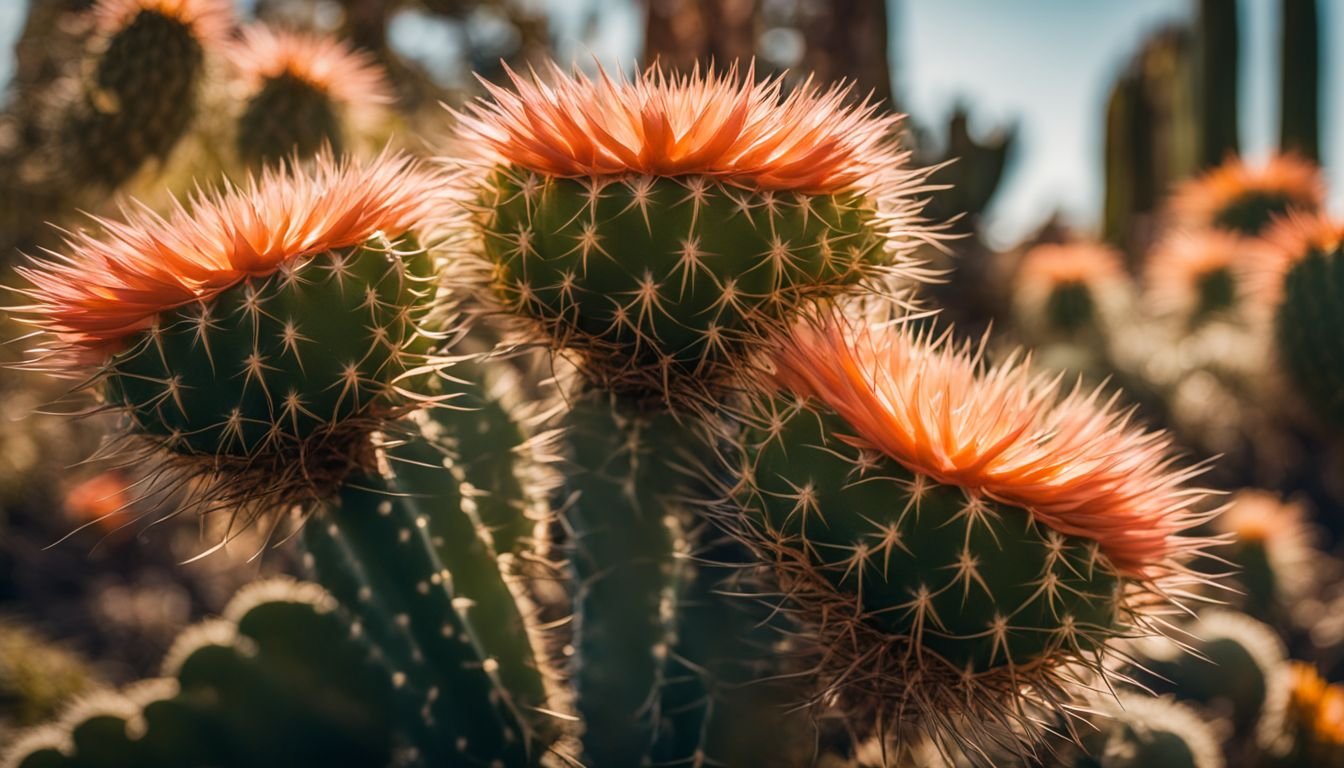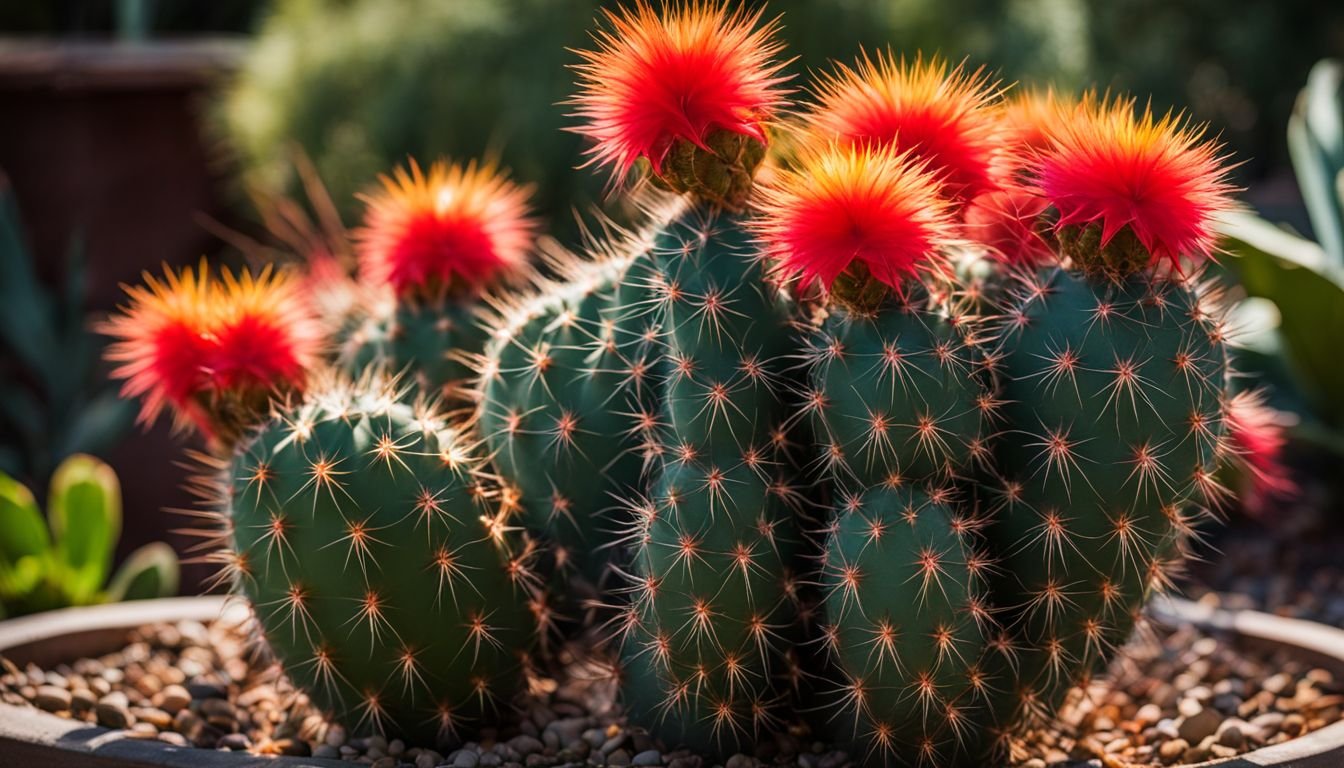Finding it a bit of a challenge to bring something truly special into your garden or indoor plant collection? You’re certainly not on your own there. Plenty of us here in Australia are constantly on the hunt for that standout plant that doesn’t just merge with the rest, but really pops.
We’ve felt that frustration too and know exactly where you’re coming from. That’s led us to uncover one option that really hits the mark – the Monkey Tail Cactus, or as those in the know call it, Cleistocactus winteri.
This cactus is an absolute ripper with its striking appearance and easy-going nature. It’s right at home in conditions many of us find ourselves dealing with in Oz, making it a top pick for our gardens and living spaces.
Our rundown will guide you through everything from getting this distinctive cactus planted to ensuring it stays chipper all year round. We’ve got hints on tackling pests, sorting out its watering needs, and how to provide top-notch care without a fuss.
Keen for a bit of gardening exploration? Stick around!
Key Takeaways
- Grow your Monkey Tail Cactus in a sunny spot but shield it from the harsh afternoon sun to avoid damage. Use well-draining soil and ensure the pot has good drainage to prevent root rot.
- Keep an eye out for common pests like mealy bugs, spider mites, and scale. Use organic solutions such as insecticidal soap or introduce natural predators like ladybugs into your garden to manage them.
- Water the cactus sparingly, only when the soil is completely dry. Reduce watering during cooler months when the plant enters a dormant phase. Excess water can harm your cactus more than drought will.
- Prune dead or damaged stems with clean tools to keep your cactus healthy and maintain its shape. Repot every 2-3 years into slightly larger pots with fresh, fast-draining mix to support growth.
- Protect your Monkey Tail Cactus from frost by growing it in pots that can be moved indoors in cooler weather since they don’t handle cold well.
Details about the Monkey Tail Cactus

Moving on from the introduction, we delve deeper into the essence of the Monkey Tail Cactus. This unique plant, known scientifically as Cleistocactus winteri or Hildewintera colademononis, captivates with its unusual appearance.
It proudly displays mid-green stems covered densely in golden to silver spines that closely resemble a playful monkey’s tail. Gardeners treasure it for both its striking look and the brilliant, salmon red flowers it produces.
“The Monkey Tail Cactus stands out not just for its fascinating shape but also for its ornamental qualities and easy care.”
We find ourselves drawn to this cactus not only because of its beauty but because it suits our Australian climate perfectly. It thrives under conditions that mimic their natural habitat—requiring minimal water and well-drained soil to prevent root systems from getting too wet.
Positioned best in areas where they can bask in plenty of light without suffering under the harsh afternoon sun, these plants make an excellent addition to any garden or home collection as houseplants or ground cover options in sharp drained soils free of frost risk.
Growing the Monkey Tail Cactus in Australia

Growing the Monkey Tail Cactus, or Cleistocactus colademononis, in Australia needs us to pay attention to a few specifics. This plant loves bright sunlight and well-drained soils which means picking the right spot and preparing your soil with care are key steps.
We must mix potting mix with sand or perlite to make sure water flows through easily, helping prevent root rot. Also, using wood chips on top of the soil helps keep moisture in without letting the base get too wet.
When it comes to pests like spider mites that can trouble our monkey tail cacti, we have effective strategies up our sleeve. A simple spray of insect-killing soap does wonders in keeping these tiny nuisances at bay.
It’s crucial for us gardeners to keep an eye out for any signs of these pests so we can act fast and keep our plants healthy.
By creating just the right environment and staying vigilant against pests, growing a vibrant monkey tail cactus in Australia becomes not just
Ideal conditions
We love sharing our passion for gardening, especially when it comes to unique plants like the Monkey Tail Cactus. Here’s how we ensure they thrive in Australia.
- Place your cactus in a spot that gets plenty of sunlight but is shielded from the harshest afternoon rays. This plant loves the sun but too much direct heat can harm it.
- A well – draining soil mix is crucial for preventing water from pooling around the roots. We often use a special cactus potting mix that allows water to flow through easily.
- Although this plant enjoys sunny spots, make sure it also gets some filtered light, especially during the peak summer months. This mimics its natural habitat conditions.
- During planting, consider adding a little mulch around the base of your cactus. This helps keep moisture in and ensures the soil doesn’t dry out too fast.
- Keep humidity levels around your plant moderate. Too much moisture in the air can lead to issues. In dryer areas, occasional misting might help but do so sparingly.
- Frost tender means these plants don’t handle cold well. If you’re in a cooler part of Australia, it’s best to grow your Monkey Tail Cactus in pots that can be moved indoors during colder seasons.
By following these steps, we’ve managed to create ideal conditions for our Monkey Tail Cacti to not only survive but flourish, showcasing their bright salmon red flowers proudly.
Common pests and how to manage them
After setting up the perfect spot with ideal conditions for your Monkey Tail Cactus, it’s time to focus on keeping it healthy by tackling common pests. These unwanted guests can cause harm if we don’t address them promptly.
Here’s how we keep our plants happy and pest-free:
- Inspect regularly for signs of scale, spider mites, and Mealy Bugs. Catching these critters early makes a big difference.
- For spider mites, we mist our cacti often. This simple act increases humidity around the plant, making it less inviting for mites.
- Encountering Mealy Bugs? We take a cotton swab soaked in alcohol and gently dab at them. This method removes them without harming the plant.
- Spotting scale is annoying but fixable. We use a soft toothbrush or fabric soaked in soapy water to carefully brush them away from our cactus.
- We adopt natural enemies of these pests, like ladybugs, as allies in our garden to maintain balance without chemicals.
- If an infestation gets out of hand, we opt for organic pesticides or insecticidal soap instead of harsh chemicals. This way, we protect not only our Monkey Tail Cacti but also the environment around us.
- Adequate watering and feeding schedule strengthens our plants, making them less likely to succumb to pest attacks.
- We ensure the potting soil is fresh and well – draining since a healthy start reduces stress on the plant which can attract pests.
By staying vigilant and adopting these straightforward strategies, we keep our Monkey Tail Cacti thriving and free from pests that could damage their bright salmon red flowers or vibrant green stems.
Caring for the Monkey Tail Cactus
Taking care of your Monkey Tail Cactus is easy if you know how to do it right. It needs just the right amount of water and regular trims to keep looking its best.
Watering needs
We all love the vibrant, salmon red flowers of the Monkey Tail Cactus and finding one in stock is always a thrill. To keep it thriving, getting the watering right is key. Make sure to water this cactus only when its soil has completely dried out.
This means checking the potting mix before adding any water. In Australia’s warmer months, you might find yourself reaching for the watering can more often. That’s just fine as this plant prefers a bit more hydration during hot spells.
Cooler weather signals a change in your cactus care routine. From late fall through winter, these unique plants enter a dormant phase. During this time, they need much less water than usual.
It’s crucial to ease up on watering to prevent root rot, which can be fatal for your cactus friend. Always use a quick-draining cactus mix specifically designed for succulents and other desert dwellers like aporocactus flagelliformis (the scientific name for Monkey Tail Cacti).
This special soil ensures excess moisture moves away from roots swiftly, keeping them healthy and dry.
Ensuring your Monkey Tail thrives doesn’t have to be complicated or involve intricate tools—simple checks with your finger to test soil moisture does the trick nicely! With bright days on our side here in Australia and AusPost ready to deliver any gardening supplies we might need directly to our doorsteps, caring properly for these fascinating plants becomes an enjoyable part of our gardening ventures.
Pruning and maintenance
After figuring out the water needs, let’s focus on trimming and upkeep of the Monkey Tail Cactus. This plant loves our care but doesn’t ask for much. Here are some straightforward steps to keep it thriving:
- Trim only dead or harmed stems. We use clean, sharp garden scissors for this job. It helps prevent any disease from spreading and keeps the cactus looking its best.
- Every 2-3 years, it’s time to change houses for our cactus friend. We pick a new pot a bit larger than the old one and fill it with fresh, fast-draining earth mix. A well-draining mix is crucial to avoid soggy roots.
- Overwatering is a big no – no. These desert dwellers prefer to stay on the dry side rather than in wet soil.
- Keep an eye out for unwanted guests like mealybugs and scale bugs. We check regularly beneath leaves and near stem bases where these pests like to hide out.
- If pests show up, we act fast with eco-friendly insecticides or make our own soap-water mix to gently wash them away.
- Once in bloom, expect to see bright, salmon red flowers that add a pop of colour and joy around your home or garden space.
- Don’t forget about companionship; introducing Tillandsia or other similar companions can create a stunning desert display in your garden area.
Taking these measures ensures our Monkey Tail Cactus stays healthy and provides us with green joy all year round without demanding much effort from our side.
Conclusion
Growing and taking care of a Monkey Tail Cactus in Australia offers much joy. With its unique appearance and simple needs, this plant becomes a striking addition to any garden or home.
Make sure you give it enough light but protect it from harsh afternoon sunburns. Remember, watering should be minimal; let the soil completely dry out first. And if pests show up, tackle them quickly to keep your cactus happy and healthy.
Embrace these tips for a thriving Monkey Tail Cactus that turns heads with its remarkable growth and blooms!
FAQs
1. Where should I plant my Monkey Tail Cactus?
Plant your Monkey Tail Cactus in a spot that gets plenty of sunlight and has well-draining soil.
2. How often do I need to water my Monkey Tail Cactus?
Water your cactus sparingly, only when the soil is completely dry, typically every two to three weeks.
3. Does the Monkey Tail Cactus need any special fertiliser?
Use a low-nitrogen cactus fertiliser during its growing season for best results.
4. Can the Monkey Tail Cactus survive cold weather?
The Monkey Tail Cactus prefers warm climates and should be protected from frost and freezing temperatures.
5. How do I know if my Monkey Tail Cactus is healthy?
A healthy Monkey Tail Cactus will have firm, green stems without any signs of discolouration or damage.
